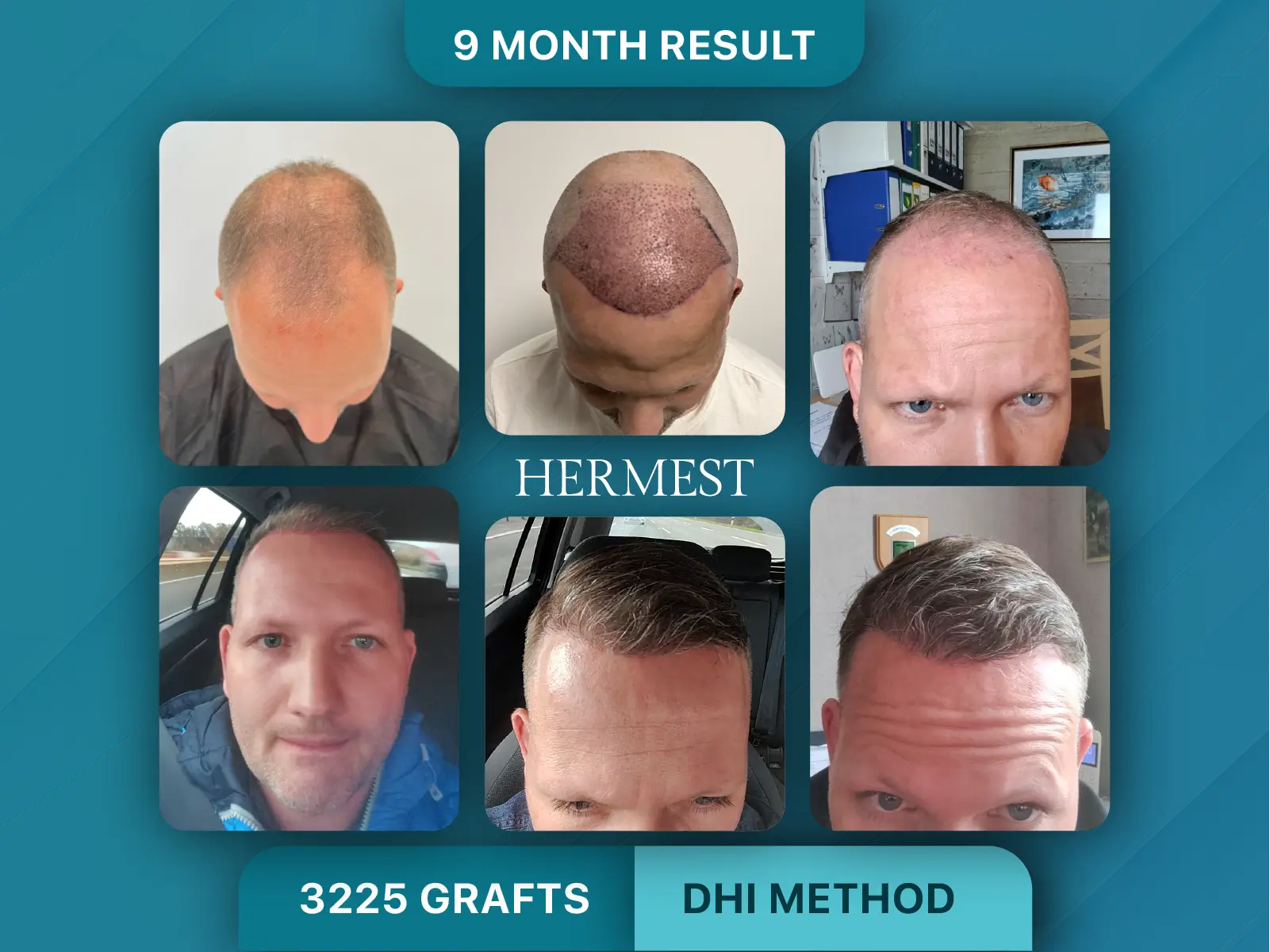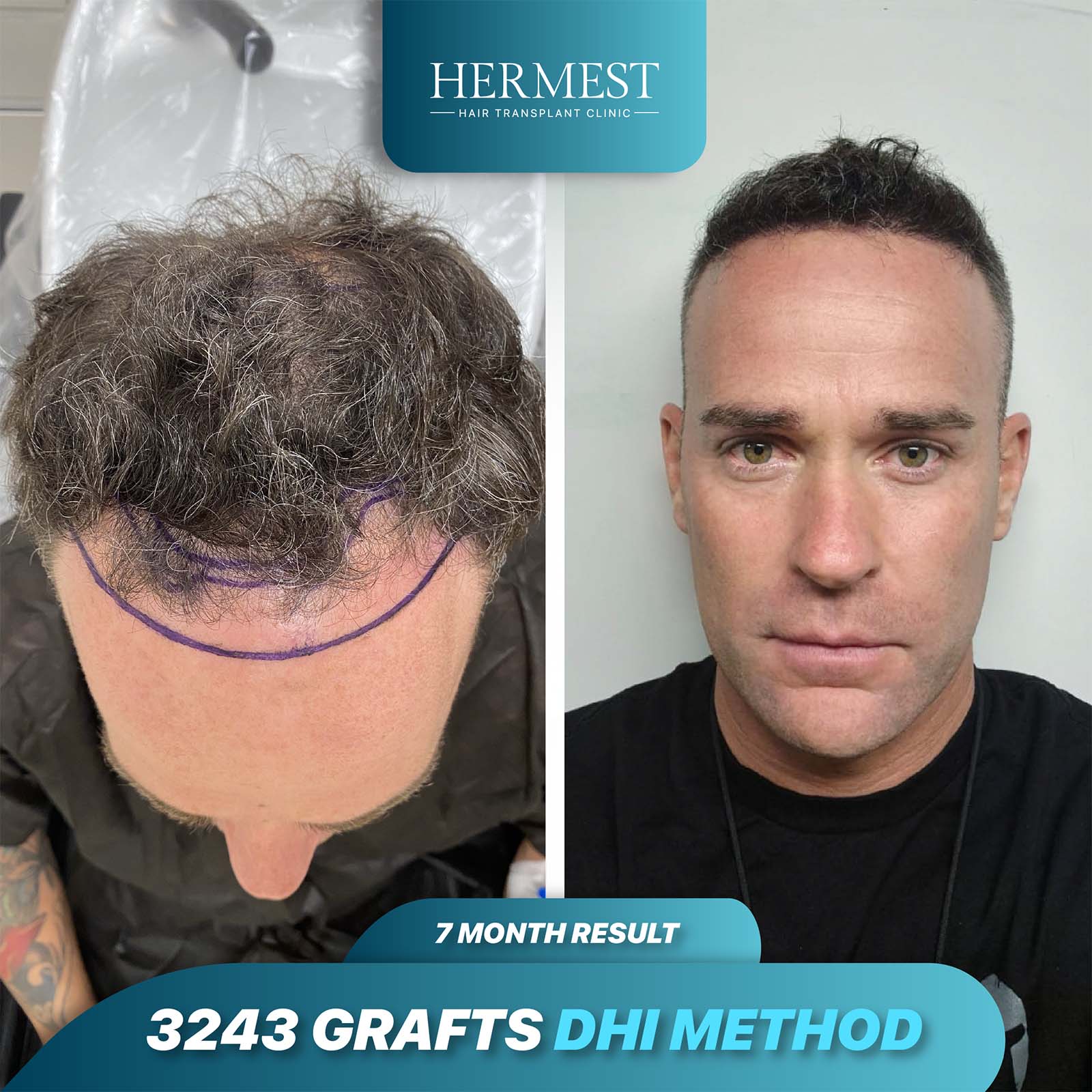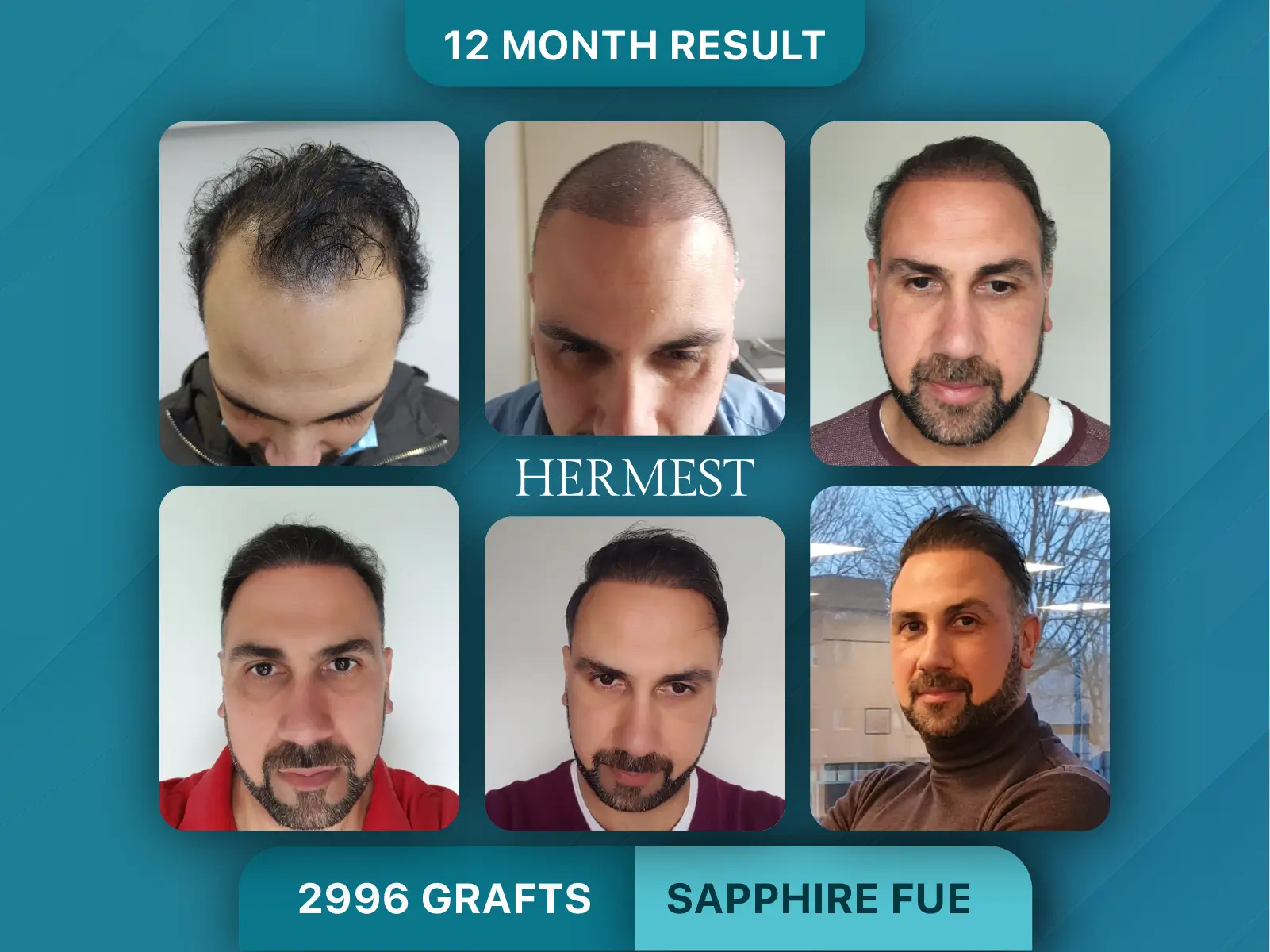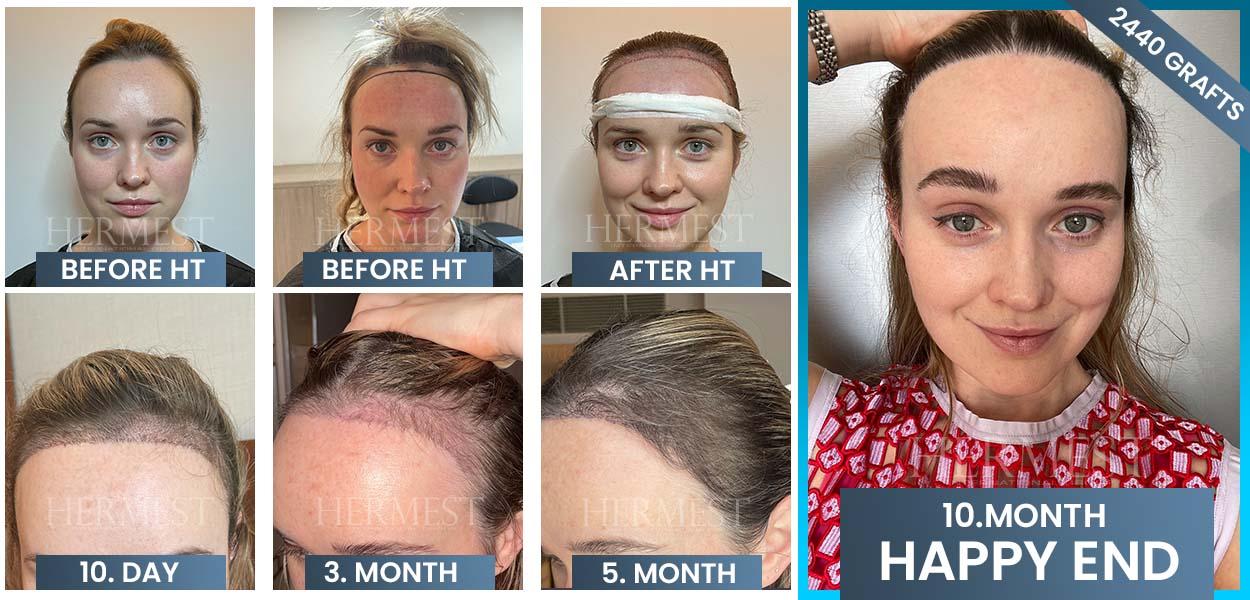You’ve probably seen it that those perfect hair transplant before-and-after photos from Turkey that look like two different people. Clean fade, sharp jawline, new confidence. But here’s the truth few mention: real hair transplant results don’t appear overnight. They unfold, slowly and quietly, over twelve months of healing, shedding, and regrowth.
When we visited Istanbul’s leading clinics, the difference wasn’t in fancy tech or slogans. It was in patience. Every top doctor we met repeated one version of the same message: results are earned through biology, not marketing.
According to a 2024 review published on PubMed, grafts typically enter the growth phase between three and five months post-surgery, with final density achieved around month twelve. The American Academy of Dermatology (AAD) also adds that up to 90% of transplanted hairs begin growing within the first year, provided post-op care is consistent. These are averages, not promises.
Dr. Gökhan Bilgin (Smile Hair Clinic): “Patients focus on what happens in the first month. But success depends on what the scalp does in month six. That’s where the real story begins.”
We saw that story in person. A patient showed us his 12-month photos: uneven density at month four, patchy crown at month six, then full, seamless coverage by month eleven. His donor area? Still healthy, because his surgeon extracted within safe limits, respecting the follicle’s natural spacing.
That’s the heart of it: a natural hair transplant result looks unnoticeable. No harsh lines, no overfilled crowns, just balance. And in Istanbul, where over half a million people come yearly for this procedure (per ISHRS Global Census 2024), the clinics that stand out are the ones that teach patients to wait, and care, the right way.
Now, we’ll show you exactly what “good results” actually look like, how to read those glossy before-and-afters like a pro, and the visual cues that separate real artistry from clever lighting.
At a Glance: Hair Transplant Results in Turkey
- Results take time, not magic. Most patients see visible change between months 3 and 6, with full results at 12 months. Early shedding and uneven growth are normal stages of healing, not signs of failure. Patience is part of the process.
- Doctor-led care defines success. Only licensed surgeons are allowed to perform or supervise surgical steps. Consistent doctor involvement remains the single biggest factor in long-term graft survival.
- Real photos show reality, not perfection. Authentic before-and-after images include consistent lighting, angles, and donor-area views. Overly edited or cropped photos are warning signs. Transparency builds trust.
- Technique should match your case. FUE offers reliable coverage, DHI excels in detailed design, and Sapphire FUE minimizes healing time, but the right choice depends on your scalp, not online trends.
- Safety is science, not sales. Verified licenses, sterile environments, and structured aftercare prevent most complications. Over 80% of post-op issues come from improper hygiene or unlicensed practice.
- Your donor area is your lifetime investment. A well-managed donor ensures you can have future touch-ups if needed. Overharvesting for short-term density risks permanent thinning later.
What “Good Hair Transplant Results” Actually Look Like
Let’s be honest, most people scroll through hair transplant results from Turkey like they’re shopping for miracles. The photos look flawless. The fades are sharp. But when we sat in on follow-up appointments at many clinics, we saw something those glossy grids don’t show: time. True, lasting results grow in phases, not filters.

A natural result doesn’t shout. It whispers. The hairline isn’t ruler-straight; it has soft, irregular flow. The density isn’t crammed; it blends. And the donor area? It looks untouched, which is the ultimate proof of a skilled extraction.
According to a systematic review on follicular graft survival rates (PubMed, 2024), average graft survival sits around 90–95% when extraction angles, hydration, and channel depth are precisely controlled. Those percentages only mean something, though, if the hairline design fits the patient’s anatomy.
Dr. Ahmet Murat (Hermest Hair Clinic): “You can have 5,000 perfect grafts and still fail if the direction is wrong. My rule? Every follicle should grow as if it was always there.”
Donor area: the hidden proof
When patients ask us how to spot a trustworthy before-and-after, we tell them to start from the back of the head. A smooth, evenly textured donor area means the doctor respected extraction spacing and didn’t overharvest. That balance keeps the donor usable for future touch-ups and prevents the “see-through” look that becomes visible under sunlight.
A PMC study (2018) on FUE donor outcomes confirmed that surgeons who extract less than 15% of total donor density per session preserve visual fullness without visible scarring. That’s one reason Turkish surgeons known for artistry, and often perform smaller, detail-focused sessions rather than mass grafts.
The illusion of density
Good results are more optical than mathematical. Human eyes can’t count follicles; they perceive shadow and direction. So even a moderate graft count can look dense if the angle and layering mimic natural growth. That’s why artistry matters as much as anatomy.
Hair Transplant Results Timeline: Month-by-Month in Turkey
Weeks 1–2: The recovery phase nobody talks about
This is when reality hits. Your head feels tight, swollen, and tender. Tiny scabs form over every graft, proof the follicles have found new ground. Most best hair transplant clinics in Istanbul handle this phase closely, providing pH-balanced shampoos and saline sprays to keep the scalp hydrated.
A StatPearls (NCBI, 2024) clinical overview notes that grafts anchor securely within 7–10 days, while inflammation subsides by the end of week two. It’s uncomfortable, yes, but normal. Don’t panic if the implanted hairs start shedding, that’s the body’s reset button.
Dr. Güncel Öztürk (HairNeva Clinic): “When you see those hairs fall out, don’t lose faith. What matters is what’s left beneath the surface, that’s where the growth begins.”
Months 1–3: The “shedding storm”
By week four, shedding accelerates. Up to 90% of the transplanted shafts fall out as follicles shift into the telogen (resting) phase. It looks worse before it looks better. A PubMed review on graft survival (2024) confirms that follicular bulbs remain viable through this stage, and regrowth begins around the 10–12 week mark.
Patients often describe mild scalp itching or “peppering” sensations, signs of revascularization as new blood supply connects. Doctors told us they actually consider this a milestone, not a setback.
Dr. Güncel Öztürk (HairNeva Clinic): “If you’re shedding evenly, it means the blood flow is healthy. Irregular loss can indicate tension or trauma, that’s why we guide every patient daily during month two.”
Months 4–6: The first visible transformation
This is where optimism returns. Fine, soft hairs break through, especially at the temples and frontal zone. By month five, about 50–60% of grafts are growing. Density isn’t there yet, but texture and coverage start improving rapidly.
ISHRS 2024 data reports that 70% of patients show visible coverage by month six, provided post-op washing, nutrition, and sun protection are followed. The donor area, if extracted carefully, should now look fully healed.
Clinics call this the “confidence checkpoint”, not because it’s perfect, but because patients finally glimpse what’s ahead.
Months 9–12: Density, texture, and natural movement
By this stage, most of the growth has matured. Hairs thicken, texture evens out, and the hairline softens into its final shape. Crown coverage, the slowest to fill, often peaks around month twelve.
A PMC study (2024) on long-term outcomes found that graft caliber and scalp elasticity reach equilibrium roughly one year post-transplant, marking true “final results”.
Dr. Gökhan Bilgin (Smile Hair Clinic): “The biggest surprise for patients isn’t density. It’s when their new hair finally starts to behave, when it moves, bends, and catches light like it used to.”
Months 12–18: Final refinement
Late bloomers exist. Between months twelve and eighteen, new sprouts still appear in crown or side areas. Minor texture mismatches fade as transplanted hair adapts to natural oil production.
This is also the moment for fine-tuning: PRP boosters, scalp massages, or low-level laser therapy, all proven by AAD clinical guidelines to strengthen follicular metabolism.
By month eighteen, you’re not seeing a result anymore. You’re living in it.
Technique Outcomes: FUE, DHI & Sapphire FUE Results Compared
FUE – Balanced coverage and healing
Among modern methods, FUE (Follicular Unit Extraction) remains the most popular technique used in Turkey. It offers balanced coverage, natural density, and relatively fast recovery. Each follicle is extracted individually and implanted into pre-made channels. When performed by skilled surgeons, it can yield graft survival rates above 90%.
According to a 2024 StatPearls review on hair transplantation, FUE provides predictable results for patients with stable donor density and medium-to-thick hair shafts. The healing period is short, around 7–10 days and scarring is minimal when punches are under 0.9 mm in diameter.
DHI – Precision for design-focused cases
DHI (Direct Hair Implantation) is often chosen for hairline work or smaller, detail-oriented procedures. It uses an implanter pen that allows the surgeon to control angle, depth, and placement simultaneously. The result? More refined frontal density and natural hair direction, especially for patients with limited thinning or localized loss.

A PubMed comparative study (2023) found that DHI procedures achieved slightly higher graft survival rates in high-precision areas like the temples and beard zone but required longer operating times and closer graft handling to prevent dehydration.
Sapphire FUE – The evolution of finesse
Sapphire FUE refines standard FUE by using sapphire-tipped blades instead of steel. These tools create smoother, narrower channels, reducing tissue trauma and accelerating healing. Patients treated with this method often report faster redness recovery and more even growth texture by the third month.

According to a PubMed meta-analysis (2024) on incision materials, sapphire blades enhance microcirculation and minimize scab formation, supporting stronger graft adaptation. This makes the technique a smart choice for people with finer hair types or for those seeking minimal downtime.
Which technique delivers the best results?
There’s no one-size-fits-all answer. For broad coverage, FUE remains the workhorse. For refined areas like temples or beards, DHI offers precision. And for faster healing with less irritation, Sapphire FUE is often preferred.
Ultimately, the surgeon’s experience defines success. The right method depends on your hair type, donor strength, and recovery goals, not what’s trending online.
Reading Hair Transplant Before-and-After Photos Like a Pro
Why photos can mislead you
Search “hair transplant results in Turkey” and you’ll see endless galleries, same angles, perfect fades, glowing reviews. But not all photos show the whole story. Some are taken too soon, others under flattering light, and a few are digitally softened to hide redness or density gaps. Real outcomes are easier to spot once you know what to look for.
The ISHRS emphasizes that authentic before-and-after documentation must show consistent lighting, angles, and both donor and recipient areas. Without that, comparisons lose meaning. Transparency is the new trust signal.
How to spot authentic photos
Here’s a simple checklist we use during our own clinic visits:
- Same lighting and distance. Harsh shadows or bright overhead lights can fake density.
- Visible donor area. A healthy donor means smart extraction, no patches or thinning.
- Consistent hairstyle and length. Real progress is visible even when hair is wet or combed differently.
- Subtle irregularities in the hairline. Perfect symmetry usually means overdesign or digital retouching.
- Detailed time stamps. Look for labels like “3 months,” “6 months,” and “12 months” that match biological growth stages.
A PubMed study (2024) reviewing 200 patient photo sets found that misleading lighting and missing donor images were the top causes of false density perception. That’s why patient testimonials paired with unedited photos often tell the truest story.
Donor area: the real indicator of skill
Most people focus on the new hairline, but the back of your head holds the proof. A smooth, evenly textured donor area means grafts were extracted at safe density ratios, typically 10–15% per zone per session. Overharvesting, by contrast, leaves visible gaps and scars that worsen with time.
The bottom line
Before-and-after galleries are useful only when paired with honesty. If a clinic hesitates to show donor shots or can’t explain photo lighting, it’s a red flag. A good result speaks for itself, from every angle.
Special Cases: Women, Beard & Afro Hair Transplant Results in Turkey
Female hair transplant results
Women often approach hair transplant results in Turkey with mixed emotions, hope and hesitation. That’s because female pattern loss behaves differently from men’s. It’s more diffuse, spreading across the top and sides instead of forming defined bald spots. The goal isn’t to cover empty skin; it’s to thicken what’s thinning.

Female transplants usually involve DHI or Sapphire FUE, where smaller tools allow surgeons to work between existing hairs without shaving the head. Results take longer to appear, often 12 to 15 months, because female follicles enter growth cycles more gradually. According to a 2024 review on PubMed, women typically achieve 80–85% graft survival, with visible density improvement by month nine.
Dr. Gökhan Bilgin (Smile Hair Clinic): “We design female transplants like a painter adding texture, not volume. The aim isn’t to fill, it’s to blend naturally into what’s already there.”
Beard transplant results
Beard restoration has become one of Istanbul’s fastest-growing procedures. Patients want natural stubble density, defined cheek lines, and symmetry — without the “planted” look. Results mature slowly here too. Early growth starts at three months, but real thickness builds around month nine.
A StatPearls analysis (2024) notes that facial grafts show slightly lower survival rates than scalp grafts because of regional blood flow and thicker skin structure. The difference, however, is minimal when channel depth and hydration are optimized.
Afro-textured hair transplant results
Afro hair brings another layer of complexity. Its curved follicles require specific punch angles to avoid transection, and healing can involve prolonged redness due to increased melanin response. But when handled with care, results are extraordinary, soft volume, tight curls, and visibly thicker coverage.

Research published on PMC (2023) found that experienced surgeons using custom-blade FUE achieved 88–92% graft survival in Afro-textured cases, nearly identical to straight hair results. The key is patience: growth begins later, often around month five or six, but fullness by month twelve feels transformative.
Every hair type tells a different story, but the measure of success remains the same: natural direction, lasting density, and harmony with facial balance.
Risks and Safety Factors That Affect Hair Transplant Results
The surge of hair transplant tourism in Turkey has brought world-class results, and unfortunately, a few cautionary tales. Complications like infection, folliculitis, or uneven density don’t usually happen in accredited clinics, but in setups where procedures are rushed or delegated to unlicensed technicians.
According to the ISHRS, more than one in four global hair transplant complications come from non-physician operators. The Turkish Ministry of Health has responded with strict oversight, requiring clinics to hold an official licence and to have a medical doctor perform or directly supervise each stage of the operation.
When performed by qualified surgeons, serious side effects are rare. Minor redness or numbness typically resolves within a few weeks, while graft survival rates stay above 90% when proper technique and sterilization protocols are followed.
How patients can stay safe
Safety starts before you ever sit in the surgical chair. Always check your surgeon’s credentials through the ISHRS member directory or the Turkish Medical Association registry. Ask who will extract the grafts, who will open the channels, and who will implant them. You’re not being difficult, you’re being smart.
During our visits, clinics with the best track records followed structured safety routines:
- Limiting daily surgeries to one or two cases per doctor.
- Using sterile micro-punch systems and single-use implanters.
- Keeping detailed graft logs for every patient.
- Monitoring anesthesia and blood pressure throughout.
Post-surgery risks and how to avoid them
Aftercare mistakes cause more graft loss than surgical error. According to PubMed clinical data (Kerure & Patwardhan, 2018), 80% of post-op issues are preventable with simple hygiene and scalp protection. Avoid tight hats, sweating, and direct sun exposure for at least ten days. Gentle washing and moisture balance protect grafts during the revascularization phase.
And remember, scabs falling early or mild shock loss is normal. The key is not to panic or over-touch.
Hair Transplant Success Rates in Turkey
The numbers often speak louder than the marketing, and Turkey’s hair transplant success rates remain among the highest worldwide. Turkey performs over 500,000 procedures annually, with average graft survival rates between 90% and 95% in doctor-led clinics.
A StatPearls review (2024) supports this, noting that patient satisfaction and visible coverage reach 92% when transplants are performed under licensed medical supervision and proper aftercare protocols. But success isn’t measured only by regrowth; it’s measured by naturalness, donor health, and long-term stability.
What defines a successful transplant
From our visits to Istanbul clinics and patient follow-ups, three key variables consistently determine whether a transplant reaches that 90%+ success threshold:
- Surgeon Involvement – Every leading clinic limits daily operations so the doctor performs core steps personally.
- Donor Management – Preserving extraction density below 15% per zone ensures sustainable donor use for future sessions.
- Aftercare Compliance – Most graft losses happen post-surgery, not during it. Patients who follow strict hygiene, nutrition, and recovery protocols improve their success odds by 10–20%.
Setting realistic expectations
Even in top clinics, success rates vary based on individual biology:
- 90–95% – Typical survival for healthy donors, balanced extraction, and ideal scalp circulation.
- 80–85% – Common for large graft counts or low vascularity scalps.
- 70–80% – Seen in repair or scar cases, where tissue quality is compromised.
The AAD emphasizes that surgical skill must be paired with realistic goals, chasing density beyond your donor capacity can compromise the outcome. A refined, natural design ages better than a forced full look.
Turkey’s global leadership in hair restoration doesn’t come from price, it comes from consistent doctor-led outcomes, evolving technique mastery, and one simple truth: success is in the details.
Travel, Recovery & Aftercare in Istanbul
The journey doesn’t end when the surgery is over, that’s just the beginning of your new growth cycle. The first ten days after a hair transplant in Turkey determine how well your grafts survive. Most Istanbul clinics schedule the first wash on day three, followed by daily rinses with mild shampoo and saline spray to prevent crust build-up.
A StatPearls (NCBI, 2024) study found that properly maintained hydration during the first week increases graft survival by nearly 20%. That’s why good clinics provide medical aftercare kits and follow-up checks instead of sending patients straight to the airport.
Dr. Gökhan Bilgin (Smile Hair Clinic): “Those first ten days are your grafts’ oxygen. If you protect them, you protect your future density.”
Where to stay and how to plan
Many patients spend three to four days in Istanbul after surgery. Reputable clinics include accommodation near their facilities, where recovery is more comfortable. These hotels usually provide upright pillows, adjustable lighting, and hypoallergenic linens to reduce swelling and irritation.

Light sightseeing is fine after day five. Bosphorus cruises, calm café terraces, or museum visits are all safe, but crowded bazaars, Turkish baths, and gyms should wait at least two weeks. The Turkish Ministry of Health’s International Patient Unit (USHAŞ) recommends avoiding excessive heat and humidity for ten days after surgery to prevent infection and swelling.
Aftercare timeline
- Days 1–3: Rest, avoid bending and pressure on the scalp.
- Day 3: First professional wash at the clinic.
- Days 4–10: Daily gentle cleansing, light walks, no direct sun.
- Week 3: Itching fades, shedding begins (normal).
- Month 2–3: Redness subsides; early regrowth starts.
- Month 6+: Noticeable thickening and improved density.
The AAD also emphasizes consistent moisturizing, nutrition rich in iron and protein, and avoiding nicotine or alcohol for optimal healing.
When you return home
Most clinics now offer digital follow-ups, photos, WhatsApp updates, and video calls at months one, three, and six. That remote care model has become standard in Turkey’s medical tourism sector, ensuring continuity even after patients leave the country.
Recovery isn’t just physical; it’s emotional. Around the six-month mark, nearly every patient experiences that small moment in front of the mirror, when they see the first hint of themselves again.
Important Questions & Answers
How long does it take to see full results after a hair transplant in Turkey?
Visible growth usually starts around month three, while full density appears between months nine and twelve. About 90% of transplanted follicles enter the growth phase within the first year when proper aftercare is followed.
Is shock loss normal after surgery?
Yes, completely. Shock loss occurs as transplanted follicles shed old shafts before new ones grow. Many trusted studies showed that 70–80% of patients experience this between weeks 2 and 6. It’s temporary and doesn’t affect final growth.
How much density should I expect?
Average density after a successful procedure reaches 45–60 follicular units per cm², enough for natural coverage under normal lighting. The American Academy of Dermatology (AAD) recommends conservative graft distribution to preserve the donor area for possible future sessions.
When can I return to work or fly home?
Most travelers fly home after three to five days. You can return to desk work within a week, but physical activity, helmets, and intense sun should wait at least two weeks.
How do I confirm if a clinic is legitimate?
Look for its License on the Ministry of Health registry and check if the surgeon appears in the ISHRS physician directory. Avoid clinics that won’t name their operating doctor or offer “unlimited graft” deals.
Do female and beard transplants follow the same timeline?
Not exactly. Female and beard cases develop slightly slower due to finer graft caliber and different vascular patterns. Expect visible thickening by month nine, with full results around month fifteen.
Will I need another procedure later?
Possibly, depending on genetics and donor strength. ISHRS recommends spacing secondary sessions at least 12–18 months apart to maintain scalp integrity and stable density.
References
These are reliable sources to reference when researching clinics or post-op care:
- International Society of Hair Restoration Surgery (ISHRS) – Global ethical and technical standards.
- Turkish Ministry of Health (Sağlık Bakanlığı) – Clinic licensing and patient rights.
- USHAŞ (International Health Services Turkey) – Medical tourism support and safety regulation.
- American Academy of Dermatology (AAD) – Recovery timelines and scalp health research.
- StatPearls / PubMed / PMC – Peer-reviewed studies on graft survival, technique comparison, and donor area management.